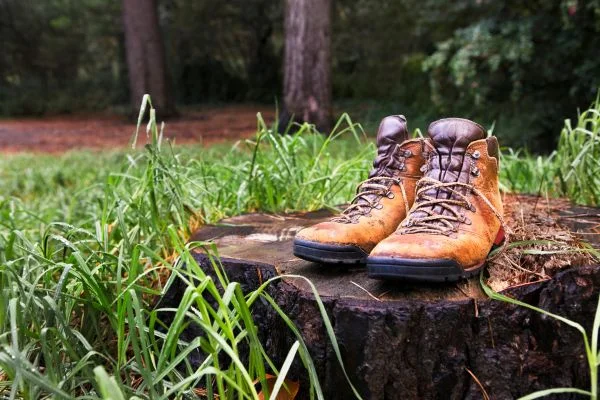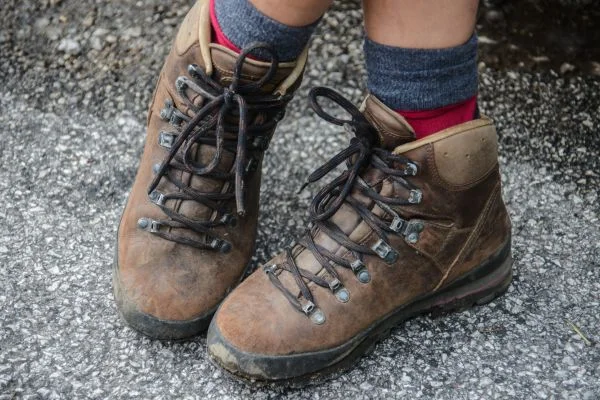Hiking boots are one of the essential pieces of gear that you need if you want to enjoy your hike. They keep your feet comfortable and safe and can make a huge difference in how much fun you have out on the trail. But with so many different styles, sizes, and materials available, it can take a lot of work to know which pair is right for you. So read our guide on How To Choose Hiking Boots that will last through all your adventures!
How To Choose Hiking Boots | Pro Tips

Find the Right Fit
The first step in finding the perfect hiking boot is ensuring it fits properly. You want your foot to stay inside the boot and have enough room between your heel and the back of the shoe. For this reason, it’s best to try on several different sizes and brands before settling on one.
The best way to ensure the boot fits correctly is by trying them on socks similar to what you would wear when hiking. This will help ensure enough space in the toe box and a snug fit around your ankle without being too tight or uncomfortable.
Also Read: How Should Hiking Boots Fit?
Consider Your Terrain
The type of terrain you plan to be hiking on should also play a role in choosing a pair of hiking boots. For example, a lightweight pair of low-cut boots may protect your feet if you mostly walk on flat trails with no significant inclines or declines.
However, if you plan to tackle more technical terrain, such as mountains or rocky paths, investing in a more sturdy pair of mid- or high-cut boots may be better for you. These boots offer extra ankle support and protection from debris like sticks and stones that can injure your feet while on the trail.
Look for Quality Materials
Finally, when selecting hiking boots, it’s essential to look for quality materials that will last through all terrain and weather conditions. For example, leather is generally considered one of the best materials because it offers excellent waterproofing and breathability, so your feet won’t get too hot or sweaty during long hikes.
Other materials, such as Gore-Tex, are also great options because they provide extra waterproofing while still allowing air circulation within the boot, so your feet stay dry even in wet conditions.
Sole Support
The sole support provided by a well-designed hiking boot helps protect against rocks and other obstacles on the trail while providing traction when walking on slippery surfaces like wet rocks or muddy trails. Look for soles made from rubber or other high-quality materials that provide plenty of grips while still being flexible enough to move with your foot over uneven terrain.
Additionally, some soles feature unique tread designs to help provide extra traction when needed; it’s worth considering these features if you plan on tackling challenging trails with lots of rocks or wet areas prone to slipping hazards.
Protection
The type of protection offered by different hiking footwear varies widely—from lightweight trail running shoes designed for speed and agility to heavy-duty mountaineering boots capable of handling extreme conditions.
Choose the type of boot that best matches how you plan on using them; if you only plan on doing short day hikes with light packs, then lightweight trail shoes may be all you need. But if you want extra ankle support for longer trips with heavier loads, then a mid-cut boot or even a full mountaineering boot might be better suited for your needs.
Also Read: How To Break In Hiking Boots?
Should You Buy Boots a Half Size Bigger?
You may buy boots a half size bigger to wear thicker socks or add additional cushioning. While this is sometimes necessary, there are better options than this. Try on boots and see how they feel, and if your boot size doesn’t quite fit comfortably, you may have better luck sizing up or down, sometimes even a full size, to achieve the optimal fit for your foot.
Shoes that are too big can cause blistering and tripping over the extra movement, while shoes that are too small can cause stiffening of your feet and limit circulation. Ultimately, whether you buy a half size up depends entirely on how they feel while wearing them.
Also Read: How To Style Your Hiking Boots For Any Adventure?
Conclusion
Now you know, How To Choose Hiking Boots? Choosing a quality pair of hiking boots can make all the difference when it comes to having an enjoyable hike—and one without any blisters!
When shopping for hiking boots, make sure to find ones with a good fit, consider what type of terrain you’ll be tackling, and look at different material qualities, so you get something that lasts through all kinds of weather conditions and surfaces. With these tips in mind, finding the right pair should be easy! Happy trails!

